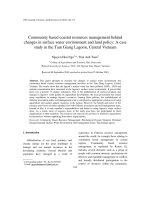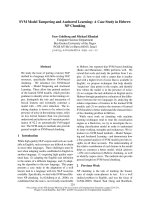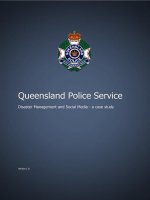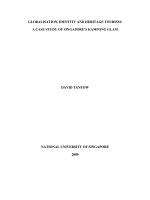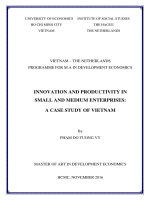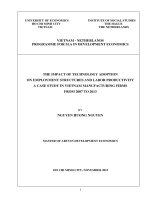1 optimized manufacturing layout and operational balancing a case study in an electronic line from the industrial pole of ManausAM, to increase productivity
Bạn đang xem bản rút gọn của tài liệu. Xem và tải ngay bản đầy đủ của tài liệu tại đây (376.13 KB, 7 trang )
International Journal of Advanced Engineering Research
and Science (IJAERS)
Peer-Reviewed Journal
ISSN: 2349-6495(P) | 2456-1908(O)
Vol-8, Issue-11; Nov, 2021
Journal Home Page Available: />Article DOI: />
Optimized Manufacturing Layout and Operational
Balancing - A Case Study in an Electronic Line from the
Industrial Pole of Manaus/AM, to increase productivity
Raimundo Wenderson da Silva Figueira, Fabiana Rocha Pinto
Department of Engineering, Faculdade Estácio do Amazonas, Brazil
Received: 10 Sept 2021,
Received in revised form: 28 Oct 2021,
Accepted: 08 Nov 2021,
Available online: 14 Nov 2021
©2021 The Author(s). Published by AI
Publication. This is an open access article
under the CC BY license
( />Keywords— Layout, Factory,
Optimization, Productivity, Flow.
I.
Processes
Abstract— In the face of an extremely complicated phase for the national
and international market, the factories are seeking ways to survive this
turbulent moment for the economy, pursuing alternatives in order to make
their processes more sustainable. So, in this way this can be possible to
remain in the midst of increasingly difficult challenges and goals, it is
understood the great importance of seeking the optimization of its
manufacturing processes through their layouts in order to be
economically stronger. Based on this, a case study was recommended to
carry out an experiment, whose main objective is to optimize the layout as
well as every part that makes up its production processes, proposing the
unification of two production lines installed in the PIM (Manaus
Industrial Pole) of the Electronics sector. With information of the
production process through the collected data, was identified in the first
layout the excesses in two production lines under study, which had the two
identical processes in common, as well as the duplication of stations, tests
and the unbalance of operational activities in oversized stream. The
update of Takt time was also necessary given the opportunities found
specifically in the packing area, with overproduction waste in certain
stations. Searching for more productivity and improvements at a low cost,
was determinate to choose the study to optimize the layout and
improvements in the flow with a reduction in the operational cost through
low-cost means. The entire experiment was accomplished with tools and
programs in free versions available on the internet and already widely
used in the industrial factory and environments, such as Sketchup, GBO
(Operational Balance Chart) and Kinovea video editing program.
INTRODUCTION
An optimization of the factory layout or its administration,
typically remains under the responsibility of the Industrial
Engineering area or the Process Engineering of the factory,
seeking to obtain the autonomy to study and transform the
current process by proposing new and more productive
processes. The study of this process gives to the factory the
flexibility to make decisions regarding the adaptation to
www.ijaers.com
new technologies such as new machines or new production
methods that take up less space than manual processes,
replacing those that depends on more people or large
occupation of the factory area. Each production process
has its particularity, and having a detailed layout in your
hands is knowing exactly what you can and cannot do, in
other words, it means perhaps being one step ahead in a
market that is always very competitive, making possible to
Page | 134
Silva Figueira et al.
International Journal of Advanced Engineering Research and Science, 8(11)-2021
be ready for a quick and strategic change in the factory
layout, with a short-term financial return and
implementation of low-cost projects.
According to [1], the layout is the arrangement of
men, machines and materials, which allows integrating the
flow of materials and the handling of needed equipment,
yield and movement, so that the storage takes place within
the standard of economy and efficiency. Along these lines,
the correct positioning of machines, inputs, products and
equipment contribute to minimizing waste, both those
related to movement, production such as stock and waiting
[2].
The proper sizing of the layout provides to the
organizations an efficient communication progress,
between units, in which the company's available area
makes the workflow more efficient [3]. This way, one of
the major obstacles faced by industrial companies,
regardless of the size of the factory, is the adaptation or
redesign of the layout according to growth, in view of the
need to produce new products or, in other words, to
comply with the constant demand of the customer.
Therefore, more and more the market demands that
companies be ready to adapt their processes, enabling new
ways to produce, optimizing their physical arrangement,
and increasing their productivity.
Productivity is the real usage of all and any
available resource, it is often confused exclusively with
production and just to produce not always mean to have
productivity, usually the productivity does not appear with
a set of improvements which can make the productivity to
be always and constantly in a production process if this
process is controlled and mapped frequently. Thus, the
elimination of downtime is an important action to obtain
and to produce more with less cost, where the same hours
lost during the production process can be transformed into
productivity.
Regarding productivity, according to [4] time
management is a contribution to personal life planning.
Facing this competitive scenario in the industrial market,
many factories focus on mapping and studying different
ways in order to have in hands solutions that show the best
usage of their industrial structure as a whole, as well as
their machines, raw material, labor and its capital
altogether. The choice of tool will depend on some factors,
for example: type of layout intended, amount of
information available or designer's preference [5]. The way
the design of a physical arrangement or layout is designed
directly reflects on the productivity of a production line
installed in a factory that depends on various processes to
be efficient in its output, considering all the points
www.ijaers.com
described above and highlighted by its importance in
designing a layout to become efficiently productive.
This study describes the transformation of a factory layout
comparing its current and future process after
improvements made through flow and balancing studies
that led to a new process design, as a condition to prove
the improvements made, pursuing more productivity and
optimization in two lines of production through possible
eliminated waste, followed by presentation and detailing
with data and the result obtained with the help of specific
literature on factory layout design and lean production,
making possible to achieve the objective of this case study,
in this way obtaining more productivity through optimized
factory layout and balancing the operational process.
II.
MATERIAL AND METHODS
As reference was used a company from the PIM
(Industrial Pole of Manaus) in the Electronics sector for
process mapping and layout design adopting 3D Sketchup
software, version 2017 with a CAD (DWG) file, for the
floor plan purpose, in which the area measured was
described with characteristics of little space between
operators, with stations operating in counter-flow making
it difficult for the continuous process that should be
working without interruptions.
For the job balancing the use of Lean GBO tool
(Operational Balancing Chart), presents the optimization
of the operational production process, proposing a new
Takt in a shorter time than the current process, in which it
had bottlenecks proving the unbalance of the activities.As
an analysis, the illustration was made through the
Yamazumi graph (a graph that shows the cycle time of
each task), which in Japanese has the meaning of
“stacking” the data. According with the process
information, the Kinovea software was used for analysis
through video, where the data is read in numbers.
Considering that the tools used in this article are available
in the industrial environment, or in other words, in the
Production Engineering for the purpose of aiding in the
study of processes with mapping or ergonomic evaluation
for data collection, are an excellent support to the
engineering engineer to the professional and the
production in the industrial area.
Thus, this research is classified as descriptive [6] in
detailing a specific production process and explanatory in
identifying and understanding the cause and effects of a
production process with quantitative data comparing
before and after. This is a case study that reports the
important benefits of an optimized factory layout, showing
that the continuous study of the production process in
greater detail makes it possible to produce more with
Page | 135
Silva Figueira et al.
International Journal of Advanced Engineering Research and Science, 8(11)-2021
less.The data collection was carried out in a production
area with two assembly lines containing 30 workstations
each, with a total of 60 operators.
Before any filming in the process, it is important to
guide the person who will be filming so as not to lose any
detail of the editing process, everything is important.
The entire production process was filmed stand-bystand, the images are used for studies in the image editor
program called Kinovea, a program of French origin
proposed by Calmet in 2012, facilitating the
chronoanalysis, recording of times and detailing of the
assembly in angles, in such a way it was possible to carry
out a detailed study at each workstation where the images
generate data on the operational cycle of each operator
(Figure 1).
Collecting data from the manufacturing area, the
measurement was performed using a measuring tape and
later all the measurement data were added to the free
version drawing modeling software 3D SketChup, owned
by Google, which is a program that offers numerous tools
to transform the process in images, making possible to
offer the future vision of a proposed layout and its possible
impacts (Figure 2).
Fig.2. Construction of the current layout with the averages
collected in the available area.
Fig.1. software Kinovea timing on video.
Subsequently, the data will be presented in a
balancing graph for process optimization analysis. Each
movement is registered and quantified forming operational
cycles and based on their time averages that will feed the
graphics which will represent this process. It is important
to be aware of situations or movements that can break the
sequence of the activity, this can occur in cyclical or no
cyclical situations, which can be repetitive movements or
with variation at the end of the activity.
This video editor program called Kinovea, was an
important tool used in data collecting for this experiment.
Throughout, it is also possible to observe whether the
operator is making adequate movements in carrying out
the activities, whether the filming was well done, valuing
the views during the video recording, and it is also
necessary to identify whether the trained performer or
operator is performing their activities according to the
standards established through industrial engineering. It is
possible for the operator to deviate from the standard
method. In this video analysis model, it is possible to land
the image or even slow down, zoom, so in this way details
that would go unnoticed at normal speed can be identified.
As well as inappropriate ergonomic movements that can
cause discomfort to the operator and impact the time
available to perform the activity or even each assembly
cycle.
www.ijaers.com
The figure 2 illustrates the measures added in the
software this way generating the current layout, as main
information a large area of 423.66m² was identified, but
poorly distributed with two identical production lines
capable of producing the same product models. The
location of each process was measured in relation to the
current layout, in the total space available, having as
characteristics the distance between the two production
lines measuring 4 meters between them, and 20 meters in
length from beginning to the end, with side aisles
measuring 2.4 meters illustrated via 2D drawing, enabling
the study for new opportunities of improvement. With this
software it was possible to design machines, assembly
devices, its line structure and all the jobs evaluated in this
experiment.
It is important to emphasize that since the
identification of each object part of the production, from
the detailing of each workstation, to the profile used on the
treadmill, it was designed with this software called
SketChup. An ally for engineering in 2D and 3D designs
and helps in mapping any production process, whereas
understanding the current process and proposing a future
process is easier, considering that with more detail in the
layout higher are the chances of transforming the process
safely and have less risk of errors in project execution.
With good planning it is possible to avoid unnecessary
expenses with errors in the project. This way a 2D layout
with a top view is born, in technical drawing designing the
entire process and following rules through standards
Page | 136
Silva Figueira et al.
International Journal of Advanced Engineering Research and Science, 8(11)-2021
established with the Brazilian Association of Technical
Standards (ABNT), rich in metric details characterizing the
input and output that represents the production flow of this
production process described here for this experiment.
The 3D image generated by the Sketchup software
simplifies the study of the entire production area visually,
making it easier to see the entire process and develop
solutions for a new flow in a future vision, based on the
changes made for the development of the layout (Figure
3).
Fig.3. Current 3D layout with two production lines.
One of the main benefits of working with 3D layouts
is the immediate identification of possible impacts on the
movement of machines or workstations, which can bring
negative results, impacting in productivity. The space
available for each workstation with the exact dimensioning
measurement is easily projected in this program, detailing
everything, even all the material needed for assembly per
workstation.
In 3D are also developed drawings of new devices that
help in the assembly to facilitate the installation in a
shorter time, they can be projected in the future state,
enabling a dimensional analysis of how much space they
will occupy in the future layout. These devices eliminate
many manual processes that make assembly difficult. 3D
drawing also facilitates understanding in management
presentations where technical reading becomes an
attachment to projected images, leaving lines in a superior
2D view, to three-dimensional images with rich details,
facilitating the decision making regarding all changes
made in the experiment involving the production process.
Then, in the development of the technical drawing, the
main orthogonal views are projected as: A. Front; B.
Higher; C. Side.
III.
RESULTS AND DISCUSSIONS
chronoanalysis data obtained from the study of the
workplaces, a proposal for a new layout and operational
balance was reached.
The first step was to detail the process in the current
layout, observing the entire manufacturing area described,
this way, presenting more possibilities to produce more
with less space.(Table 1).
Table 1. Improvement opportunities in the current state.
The points raised were seen as opportunities for
improvement with a low investment cost, since it was a
process with characteristics of operational unbalance,
disposal of materials beyond the reach of operators,
without (Golden Zone), bottlenecks in the process,
overproduction in stations, non-standard production
processes in a specific layout with opportunity for
improvement, dealing with two identical lines in their
production processes. Then, raise the opportunities in
operational balance analyzing the current state.
Taking into account that each line produced the same
product model as the other, and that its machines and
testing equipment had the same quantity in both lines,
adding to the information obtained in the current GBO
graph (Operational Balancing Graph) which the packing
stations located at the end of the process are faster in their
cycles activities, so they can deliver their respective
assemblies in a shorter time than the initial part of the
station line, showing the unbalance of activities in the
same production line in layout format “I”.
For a better analysis, the production lines were
divided into two parts: assembly and packaging. This way
the process became clearer, where the use of design
software for the visual of the current process became more
evident and clearer.
As one of the first information obtained from the
study, the chronoanalysis made evident in numbers that
there were processes with greater production capacity, as
well as the packaging that had manyoperators being part of
this process, in the production line, which could be better
distributed.(Table 2).
Analyzing all the information on the production
process of this factory located in the Industrial Pole of
Manaus (PIM), considering the total area distributed to the
two production lines with their layouts, plus the
www.ijaers.com
Page | 137
Silva Figueira et al.
International Journal of Advanced Engineering Research and Science, 8(11)-2021
Table 2. Opportunities for improvement in the future state.
production line process with the highest production
capacity.
Evaluating the result above, there are two production lines
that before the experiment used to produce individually at
a takt of 12,8 seconds 281 pieces per hour, and had a shift
capacity of 2.306 per shift with the quantity of 30
operators per production line.(Table 3).
Table 3. Results by production line.
The opportunities highlighted in the study of the
current layout resulted in the unification of the processes
for their similarities supporting this proposal, eliminating
the duplication of workstations that were repeated when
the processes were analyzed together. Has been observed
the opportunity to optimize the space available to produce,
the arrangement of materials in the workstation resulted in
the elimination of unnecessary movements with the
application of the Golden Zone, which means the best
arrangement of materials in the operator's gold zone. A
better detailing in the work instruction avoided deviation
from the established assembly standard. With the
chronoanalysis and the balancing of activities, it was
possible to optimize workstations. The development of
devices that assist in production, streamline the process
and ensure standardization of the assembly cycle, making
the operating sequence more robust, without suffering
sudden variations in the established takt, because without a
well-detailed work instruction and with clearer
information, it is difficult ensure standard production
(Figure 4).
TESTE E PACKING
After the experiment, the takt was reduced to 11,8
seconds, managing to produce 281 pieces per hour and the
shift capacity was now 2.500 pieces per shift. Proving that
with the improvements made after the implementation of
the new layout unifying the production lines, there was an
increase of 24 pieces per hour, and 195 pieces per shift
with 24 people, resulting in an increase in productivity of
8,46% with optimization of 8 operators in the future state.
The table 4 informs that the takt of 5,8s defined for the
unified packing in the future state, has a production
capacity of 620 pieces per hour, multiplying by 8,2 hours
worked, the production capacity is 5.089 pieces per shift
and the previous layout produced with the two lines with
separate packings were only 4.612 pieces per shift,
showing that the unification of identical processes can
provide an optimization of operators through operational
balancing and the elimination of duplicated processes,
making it more productive and at the same time
lean.(Table 4).
Table 4. Final result of the experimente, analysing the
layoutvariables.
Fig.4. Current GBO Chart (Operational Balance Chart).
The GBO chart above was built using the times of
activities collected by workplace that make up the
information of the assembly process. The green parts are
the activities that add value directly to the product, the
activities in yellow are, for example, necessary movements
in a manual process, in this way, they do not add value, but
it is essential in this production model, and the activities in
red color are unnecessary movements or activities that will
make time available to produce more. These data prove the
operational imbalance and the identification of the
www.ijaers.com
With the optimized production flow, the result
generated more productivity in a process that produced
with more people in an optimized layout, making the area
Page | 138
Silva Figueira et al.
International Journal of Advanced Engineering Research and Science, 8(11)-2021
available for other production processes. There was also a
considerable gain with the reduction of people in this
process (Figure 5).
Fig.5. Future layout with Y-shaped production flow.
The Y layout was an option found for joining the
lines only in the packing part, where the number of
duplicated stations and tests made possible to streamline
the assembly process by reducing takt and this way
increasing production output and reducing labor at a area
from 143 m² to 91.42 m² for the usage of small processes
such as sub-assemblies that help the line with more manual
processes area 143 m² to 91.42 m².
The process became a leaner and efficient without
variations in productivity, before the unbalance of
operational activities prevented production from
maintaining constant numbers in the total daily
productions, with improvements such as optimization in
layout and in the productive operational process, this
experiment proved to guarantee a better process through
low-cost implementations proving that it is possible to
produce more with less.
The choice of tool will depend on some factors, for
example: type of layout intended, amount of available
information or the designer's preference [5].
The measurement of possible gains in the study of
the flow is one of the main objectives of this experiment,
which results in an increase in productivity and,
consequently, a reduction in labor costs. The profit can
only be obtained by reducing costs [7].
Productivity is related to better or worse use of
resources. It is the science of any business in an industry
productivity and is directly linked to the production
efficiency [8].
The current global scenario of crisis that companies
are experiencing makes them study new proposals and reread their production methods, their equipment and their
global science in relation to their productivity [9].
IV.
CONCLUSION
With the application of the layout tool as a condition
for improving productivity and minimizing waste, several
gains were analyzed such as: Lean production, producing
www.ijaers.com
more with fewer people, reduction of production
operational costs, producing only what is necessary and a
layout making this way an available area for other
production processes that can help in more productivity.
The main wastes observed were overprocessing,
defects, unnecessary movement, waiting, counter-flow and
operational unbalance, have been minimized in quantity
after the improvements realized in the scenario where two
production lines are drawn in the layout.
The layout, through the movement of the process,
presented numerous improvements, regarding the
reduction of overproduction and improvements in counterflow. Mainly maximizing the company's productivity and
reducing the expenses, such as labor, which did not add
financial gains.
In this experiment it was only possible to obtain this
result because both production lines under analysis are
identical, in other words, they have duplicated processes.
The unification of the final packaging processes of the
production lines was the great point seen as an opportunity
to transform the layout into a 'Y' format, a point where the
optimization of operators was made possible, because the
packing had oversized positions when evaluated in two
processes that produced the same product and obtained the
same production capacity. This was the main characteristic
of this production process that enabled the entire
transformation, obtaining the reduction of labor at a low
cost in the experiment, thus proving an excellent result.
REFERENCES
[1] BALLOU, Ronald. H. Logớstica empresarial: transportes,
administraỗóo de materiais e distribuiỗóo fớsica. Sóo Paulo:
Atlas, 2011.
[2] NEUMANN, C.; SCALICE, R. K. Projeto de Fábrica e
Layout. 1. ed. - Rio de Janeiro: Elsevier, 2015.
[3] OLIVEIRA, D. P. R. Sistemas, organizaỗóo e mộtodos: uma
abordagem regencial. 20. ed. São Paulo: Atlas, 2011.
[4] FLORES, G. T. Gestão do tempo como contribuiỗóo ao
planejamento estratộgico pessoal (Dissertaỗóo de mestrado,
Universidade Federal de Santa Maria, Santa Maria), 2011.
[5] NEUMANN, Clóvis; SCALICE, Régis Kovacs. Projeto de
layout. In: ______. Projeto de fábrica e layout. Rio de
Janeiro: Elsevier, 2015.
[6] PRODANOV, C.C.; FREITAS, E.C.de. Metodologia do
Trabalho Científico: Métodos e técnicas da pesquisa e do
trabalho acadêmico.2.ed. Novo Hamburgo: Feevale, 277p.
2013.
[7] BULHÕES, I. R.; PICCHI, F. A. Diretrizes para a
implementaỗóo de fluxo contớnuo em obras de edificaỗừes.
Ambiente construớdo, 2011.
[8] MOREIRA, Daniel Augusto Administraỗóo da Produỗóo e
Operaỗừes. 2. ed. rev. e ampl. – São Paulo: Cengage
Learning, 2011.
Page | 139
Silva Figueira et al.
International Journal of Advanced Engineering Research and Science, 8(11)-2021
[9] ANTUNES, Junico; KLIPPEL, Altair Flamarion; SEIDEL,
André; KLIPPEL, Marcelo Uma revoluỗóo na
produtividade: a gestóo lucrativa dos postos de trabalho –
Porto Alegre: Bookman, 194 p., 2013.
www.ijaers.com
Page | 140


